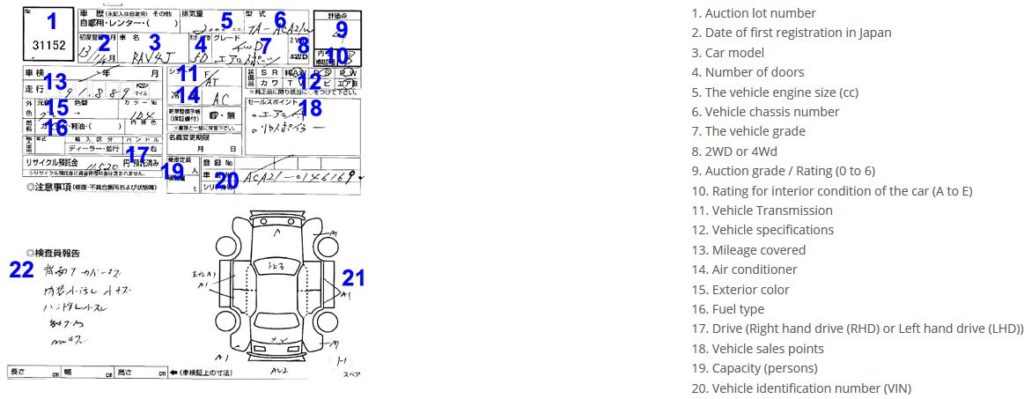If you are importing a car from Japan, chances are that you have come across an auction sheet. It could have been sent to you by your importer or you could have seen it online. Obviously if you don’t read Japanese characters then understanding it might be difficult. Yet, it contains all the relevant information on the car you are buying so understanding some to most of what it says is important.
Japanese auctions sell hundreds of cars every day. The auction system is quite efficient and has been developed so that people from far away (such as us in Kenya) can reliably buy vehicles in Japan without seeing them. It also helps to sell cars from every corner of Japan.
Before being taken the auction all the cars undergo extensive checks. These are done by professionals employed by the auction houses. These inspectors check for mechanical soundness as well as interior and exterior conditions based on a set of given standards.
They then fill out the auction sheet based on what they find. This system works and is trusted by buyers and sellers all over the world.
Guide to Auction Grades
While the auction sheet contains detailed information about the car, the auction grade gives you an idea of the general condition of the car. It is almost always enough to tell you whether to consider the car or to pass. Here is a guide on the auction grades:
There are 2 types of grading:
1. Overall grade- usually a number, based on exterior and mechanical condition of the car
2. Interior grade- usually a letter, based on the interior condition of the car. Some auction houses may use numbers 1-5.
Overall Grading
GRADE 6/7/8/S- These are brand new cars, mostly used by the manufacturers for demo purposes or with only delivery mileage
GRADE 5- The car is exceptionally clean, good as new. It will probably have very low mileage. This grade is often hard to get.
GRADE 4.5- Again very clean but slightly used, might have slightly higher mileage than grade 5. Often in great condition, sometimes as good as new.
GRADE 4- Visibly used but clean, good condition regardless of mileage
GRADE 3.5- Good condition but might have visible scratches, dents and other minor issues. Might also need minor repair work.
GRADE 3- Average condition and might be damaged, will often have very high mileage.
GRADE 2– Very poor condition, might have dents, blemishes, dirt and rust, not to mention very high mileage
GRADE R/RA – Accident repaired vehicles, or highly modified such as a whole part being replaced. Can end up being very poor quality.
Interior Grading
This denotes the interior condition of the car and will usually be graded as follows:
A- Excellent
B- Average
C- Below average
Some auction houses may use numbers 1-5, with 5 being the best, going downwards.
What is in an Auction Sheet?
After you have seen the overall grading of the car, before deciding whether to buy you need to see the rest of the details. The auction sheet will have several sections filled out in Japanese. This is what those sections represent as in the illustration below:

After you understand what each section stands for, on the illustration of the car such as in the above diagram you will see a series of letters and numbers in some of the sections. This is what they mean:
E3 – Some dents which are barely visible
U1 – A dent which is the size of a thumb
U2 – A dent which is the size of a palm
U3 – A dent which is more than size U2
Y1 – A tear which is the size of a thumb
Y2 – A tear which is the size of a palm
Y3 – A tear which is more than size Y2
W1 – A panel which has been repaired slightly, and is in good condition
W2 – A panel which has been repaired slightly, and has a slightly wave
W3 – A panel which has been repaired slightly, and has a conspicuous wave
S1 – Rust which is the size of a fist
S2 – Rust which is more than size S1
C1 – Major rust corrosion which is the size of a fist
C2 – Major rust corrosion which is more than size C1
X – A panel which needs to be replaced
XX – A panel which has been replaced

Excellent information. Thank you
Hi Johnstone, we are happy that you found this information helpful.Do not hesitate to reach out to Croton Motors for any vehicle needs